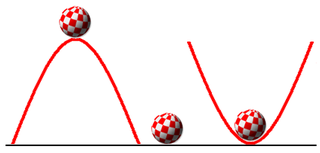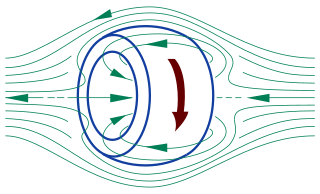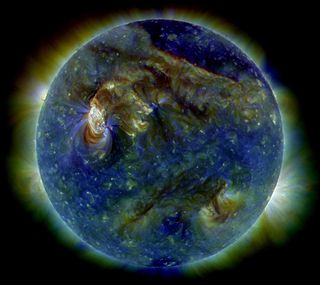Related Research Articles

The stability of a plasma is an important consideration in the study of plasma physics. When a system containing a plasma is at equilibrium, it is possible for certain parts of the plasma to be disturbed by small perturbative forces acting on it. The stability of the system determines if the perturbations will grow, oscillate, or be damped out.

An ion source is a device that creates atomic and molecular ions. Ion sources are used to form ions for mass spectrometers, optical emission spectrometers, particle accelerators, ion implanters and ion engines.

Inertial electrostatic confinement, or IEC, is a class of fusion power devices that use electric fields to confine the plasma rather than the more common approach using magnetic fields found in magnetic confinement fusion (MCF) designs. Most IEC devices directly accelerate their fuel to fusion conditions, thereby avoiding energy losses seen during the longer heating stages of MCF devices. In theory, this makes them more suitable for using alternative aneutronic fusion fuels, which offer a number of major practical benefits and makes IEC devices one of the more widely studied approaches to fusion.
Plasma diagnostics are a pool of methods, instruments, and experimental techniques used to measure properties of a plasma, such as plasma components' density, distribution function over energy (temperature), their spatial profiles and dynamics, which enable to derive plasma parameters.
Electron cyclotron resonance (ECR) is a phenomenon observed in plasma physics, condensed matter physics, and accelerator physics. It happens when the frequency of incident radiation coincides with the natural frequency of rotation of electrons in magnetic fields. A free electron in a static and uniform magnetic field will move in a circle due to the Lorentz force. The circular motion may be superimposed with a uniform axial motion, resulting in a helix, or with a uniform motion perpendicular to the field resulting in a cycloid. The angular frequency of this cyclotron motion for a given magnetic field strength B is given by
A thermionic converter consists of a hot electrode which thermionically emits electrons over a potential energy barrier to a cooler electrode, producing a useful electric power output. Caesium vapor is used to optimize the electrode work functions and provide an ion supply to neutralize the electron space charge.

A field-reversed configuration (FRC) is a type of plasma device studied as a means of producing nuclear fusion. It confines a plasma on closed magnetic field lines without a central penetration. In an FRC, the plasma has the form of a self-stable torus, similar to a smoke ring.

Extreme ultraviolet radiation or high-energy ultraviolet radiation is electromagnetic radiation in the part of the electromagnetic spectrum spanning wavelengths shorter that the hydrogen Lyman-alpha line from 121 nm down to the X-ray band of 10 nm, and therefore having photons with energies from 10.26 eV up to 124.24 eV. EUV is naturally generated by the solar corona and artificially by plasma, high harmonic generation sources and synchrotron light sources. Since UVC extends to 100 nm, there is some overlap in the terms.
The electrodeless plasma thruster is a spacecraft propulsion engine commercialized under the acronym "E-IMPAcT" for "Electrodeless-Ionization Magnetized Ponderomotive Acceleration Thruster". It was created by Gregory Emsellem, based on technology developed by French Atomic Energy Commission scientist Dr Richard Geller and Dr. Terenzio Consoli, for high speed plasma beam production.
Neutral-beam injection (NBI) is one method used to heat plasma inside a fusion device consisting in a beam of high-energy neutral particles that can enter the magnetic confinement field. When these neutral particles are ionized by collision with the plasma particles, they are kept in the plasma by the confining magnetic field and can transfer most of their energy by further collisions with the plasma. By tangential injection in the torus, neutral beams also provide momentum to the plasma and current drive, one essential feature for long pulses of burning plasmas. Neutral-beam injection is a flexible and reliable technique, which has been the main heating system on a large variety of fusion devices. To date, all NBI systems were based on positive precursor ion beams. In the 1990s there has been impressive progress in negative ion sources and accelerators with the construction of multi-megawatt negative-ion-based NBI systems at LHD (H0, 180 keV) and JT-60U (D0, 500 keV). The NBI designed for ITER is a substantial challenge (D0, 1 MeV, 40 A) and a prototype is being constructed to optimize its performance in view of the ITER future operations. Other ways to heat plasma for nuclear fusion include RF heating, electron cyclotron resonance heating (ECRH), ion cyclotron resonance heating (ICRH), and lower hybrid resonance heating (LH).

Electron beam ion trap (EBIT) is an electromagnetic bottle that produces and confines highly charged ions. An EBIT uses an electron beam focused with a powerful magnetic field to ionize atoms to high charge states by successive electron impact.
An ionization instability is any one of a category of plasma instabilities which is mediated by electron-impact ionization. In the most general sense, an ionization instability occurs from a feedback effect, when electrons produced by ionization go on to produce still more electrons through ionization in a self-reinforcing way.

Plasma is one of four fundamental states of matter, characterized by the presence of a significant portion of charged particles in any combination of ions or electrons. It is the most abundant form of ordinary matter in the universe, mostly in stars, but also dominating the rarefied intracluster medium and intergalactic medium. Plasma can be artificially generated, for example, by heating a neutral gas or subjecting it to a strong electromagnetic field.
Thermal ionization, also known as surface ionization or contact ionization, is a physical process whereby the atoms are desorbed from a hot surface, and in the process are ionized.
A non-neutral plasma is a plasma whose net charge creates an electric field large enough to play an important or even dominant role in the plasma dynamics. The simplest non-neutral plasmas are plasmas consisting of a single charge species. Examples of single species non-neutral plasmas that have been created in laboratory experiments are plasmas consisting entirely of electrons, pure ion plasmas, positron plasmas, and antiproton plasmas.
The Gas Dynamic Trap is a magnetic mirror machine being operated at the Budker Institute of Nuclear Physics in Akademgorodok, Russia.

A sawtooth is a relaxation that is commonly observed in the core of tokamak plasmas, first reported in 1974. The relaxations occur quasi-periodically and cause a sudden drop in the temperature and density in the center of the plasma. A soft-xray pinhole camera pointed toward the plasma core during sawtooth activity will produce a sawtooth-like signal. Sawteeth effectively limit the amplitude of the central current density. The Kadomtsev model of sawteeth is a classic example of magnetic reconnection. Other repeated relaxation oscillations occurring in tokamaks include the edge localized mode (ELM) which effectively limits the pressure gradient at the plasma edge and the fishbone instability which effectively limits the density and pressure of fast particles.
Ravindra Nath Sudan was an Indian-American electrical engineer and physicist who specialized in plasma physics. He was known for independently discovering the whistler instability in 1963, an instability which causes audible low-frequency radio waves to be emitted in the magnetosphere in the form of whistler waves. He also pioneered the study of the generation and propagation of intense ion beams, and contributed to theories of plasma instabilities and plasma turbulence.

The Penning–Malmberg trap, named after Frans Penning and John Malmberg, is an electromagnetic device used to confine large numbers of charged particles of a single sign of charge. Much interest in Penning–Malmberg (PM) traps arises from the fact that if the density of particles is large and the temperature is low, the gas will become a single-component plasma. While confinement of electrically neutral plasmas is generally difficult, single-species plasmas can be confined for long times in PM traps. They are the method of choice to study a variety of plasma phenomena. They are also widely used to confine antiparticles such as positrons and antiprotons for use in studies of the properties of antimatter and interactions of antiparticles with matter.

Caesium peroxide or cesium peroxide is a compound of caesium and oxygen. It can be formed from caesium metal by adding a stoichiometric amount in ammonia solution, or oxidizing the solid metal directly.
References
- ↑ Rynn, Nathan; D'Angelo, Nicola (1960). "Device for Generating a Low Temperature, Highly Ionized Cesium Plasma". Review of Scientific Instruments. AIP Publishing. 31 (12): 1326–1333. doi:10.1063/1.1716884. ISSN 0034-6748.
- ↑ Motley, R. W.; D'Angelo, N. (1963). "Excitation of Electrostatic Plasma Oscillations near the Ion Cyclotron Frequency". Physics of Fluids. AIP Publishing. 6 (2): 296. doi:10.1063/1.1706728. ISSN 0031-9171.
- ↑ D'Angelo, N.; von Goeler, S. (1966). "Investigation of the Kelvin-Helmholtz Instability in a Cesium Plasma". Physics of Fluids. AIP Publishing. 9 (2): 309. doi: 10.1063/1.1761674 . ISSN 0031-9171.
- ↑ Saeki, K.; Michelsen, P.; Pécseli, H. L.; Rasmussen, J. Juul (1979-02-19). "Formation and Coalescence of Electron Solitary Holes". Physical Review Letters. American Physical Society (APS). 42 (8): 501–504. doi:10.1103/physrevlett.42.501. ISSN 0031-9007.